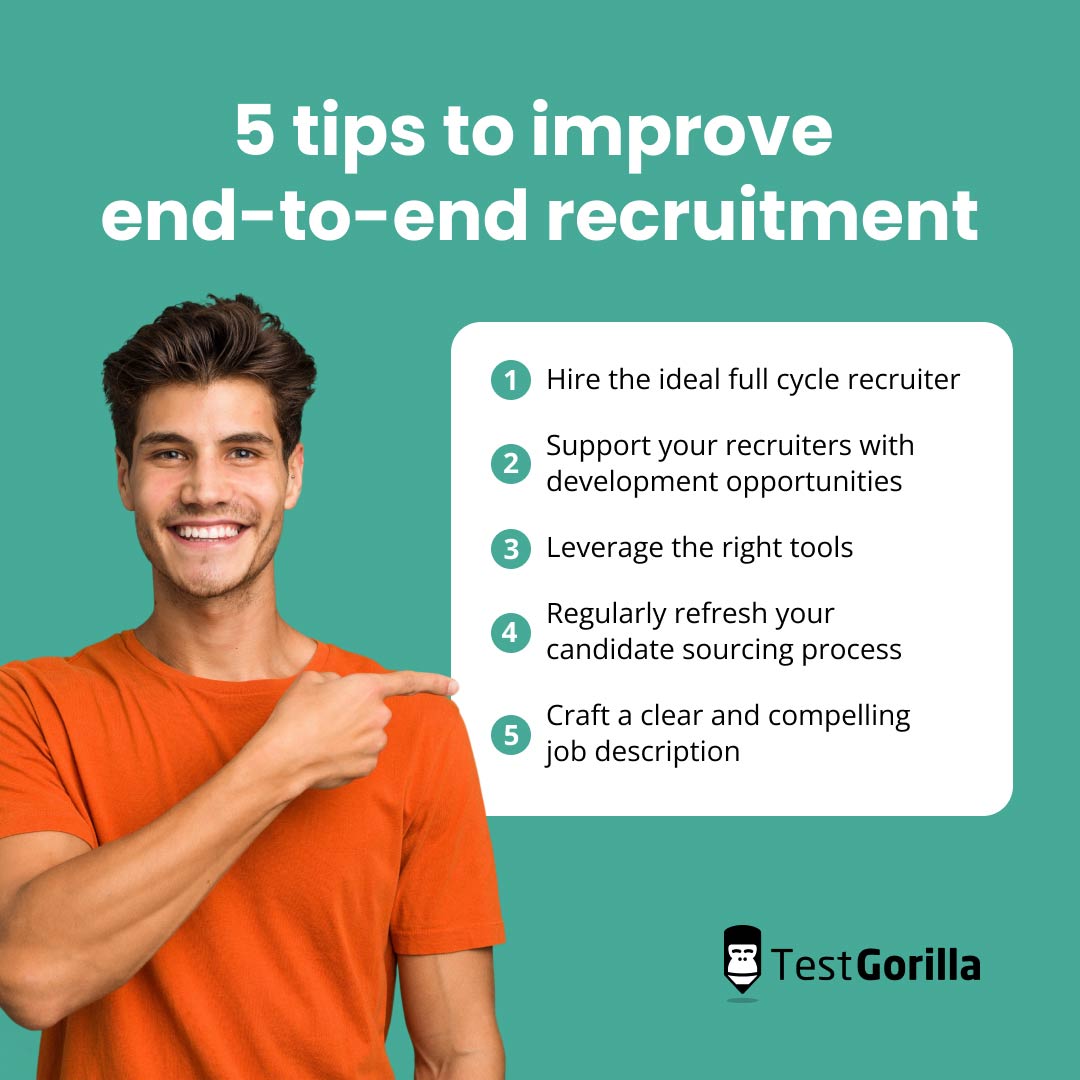Imagine you’re a candidate applying for a new position.
With every step of the process, you’re introduced to a new recruitment agent who you’ve never met and who knows nothing about you. You haven’t built rapport with anyone, and the company is, as far as you’re aware, represented by a collage of unfamiliar names. Frustrating, right?
Now, consider whether candidates applying to your company have a similar experience. Full cycle recruiting guarantees this isn’t an issue by offering candidates a single point of contact throughout the whole hiring process.
It's easy to understand how a single motivated employee nurturing applicants through the recruiting process can improve the candidate experience, reduce costs, and boost consistency.
However, full cycle recruiting isn’t a one-size-fits-all solution, and getting it wrong can often cost you just as much as you stand to gain.
With this guide, we help you determine if this talent strategy is right for you and your business. To do this, we review the pros and cons of full cycle recruiting, its six stages, and our top implementation tips.
Table of contents
What is full cycle recruiting?
Full cycle recruiting, also called end-to-end recruiting or full life cycle recruiting, is when there's one single recruiter in charge of the entire recruiting process, from start to finish. This holistic recruitment process offers candidates a more consistent experience.
The full life cycle recruiting process includes six key areas:
Preparing
Sourcing
Screening
Selecting
Hiring
Onboarding
Typically, these six steps might each be handled by two or more disjointed specialists in a traditional recruitment process, making the process inconsistent, costly, and disengaging.
However, an excellent full cycle recruiter is competent in all areas of the recruitment process and can execute each independently.
In larger companies, it’s unavoidable to have the HR department split with team members specializing in a particular aspect of the recruiting process. Nevertheless, a full cycle recruiter can still supervise the entire process and be held responsible.
The pros and cons of full cycle recruitment
There are several advantages and disadvantages to full cycle recruitment, which can help you determine if this strategy is appropriate for your company.
Let’s explore them, starting with a brief summary.
The benefits of full cycle recruiting
In this section, we explain the four major benefits of using full cycle recruitment in your hiring process.
1. Boosts accountability
Having one person in charge of each stage clarifies responsibilities.
Full cycle recruiters have complete control over the hiring process, enabling a seamless and coordinated approach. They can personally oversee each process stage, ensuring alignment with company goals and standards.
When you know who is accountable, you also always know who to turn to if there are any delays or errors.
2. Improves consistency and candidate experiences
One poll found that nearly 78% of job seekers think the quality of a candidate's experience with a company indicates how much that company values their employees.[1]
A single point of contact keeps things simple, consistent, and transparent for candidates.
Candidates often appreciate the consistency and personalized approach of full cycle recruitment. An SHRM report found that a positive candidate experience can improve the likelihood of candidates accepting job offers by 30%.[2]
A positive candidate experience creates a lasting impression and encourages 51% of candidates to broadcast their satisfied encounters on social media networks, Glassdoor, and LinkedIn.
3. Reduces time-to-hire and boosts efficiency
Time-to-hire is the amount of time it takes between when a job applicant applies and when they’re given an offer letter.
Having one person in charge of the entire process reduces delays because you aren't passing candidates between different employees.
You can significantly increase efficiency when you cut out unnecessary back-and-forths or consultations between HR managers and those in charge of hiring.
From a candidate's perspective, a shorter time-to-hire is more appealing than a long one and, therefore, creates a better candidate experience. For organizations, it leads to reduced hiring costs and less strain on understaffed teams.
Of course, you need a highly organized and hard-working full cycle recruiter to pull this off.
Another added benefit is that employing a multitalented full cycle recruiter is more affordable than having multiple people complete the tasks.
4. Gives recruiters valuable experience
Full cycle recruiting gives recruiters practical career experience in many hiring fields and helps them build new skills.
While it’s essential for them not to be overwhelmed with what they do, they can gain valuable skills thanks to the broad field of tasks they would handle.
At a high level, they gain experience like:
A holistic understanding of the organization's needs
Sourcing candidates
Interviewing
Negotiation
Onboarding
Career development is essential for modern employees, and companies that invest in their learning and development can boost retention for up to 94% of their employees.[3]
The drawbacks of full cycle recruiting
Next, let’s review a few drawbacks of a full cycle recruitment strategy.
1. Too many candidates puts strain on the recruiter
If you try to take on too many candidates at a time, a full cycle recruiter can easily get overwhelmed, and you won't be able to improve candidate experience or time to hire.
The process, therefore, is best suited for smaller, more agile companies with fewer openings.
If a large company chooses to put its recruitment team under the leadership of a full cycle recruiter, the duties must be split in such a way that the lead recruiter isn’t overwhelmed with volume while still being able to have their hands on every application.
2. Requires multiple skill sets
A successful full cycle recruiter needs various skills to do their job well. Sourcing, screening, and onboarding all require different skills, for example.
Having recruiting staff fill job openings is a different ballgame than negotiating terms or orienting new personnel. It can be challenging for one person to be adept at all of these activities.
Though such individuals are rare, plenty of qualified candidates – whether from inside your company or outside – exist to fill that role.
There are a variety of learning and development tools available to support the full cycle recruiter in their work for each stage of the recruitment process.
3. Responsibility falls on one person
Placing all your eggs in one basket can be risky.
If your recruiter makes an error or fails, a lot can go wrong. It's best to have a backup worker familiar with recruitment duties to come in for support in case this happens.
This may involve suspending full cycle recruitment in favor of traditional, segmented recruitment, but such a measure would be temporary and only in times of crisis.
Having a single recruiter also puts the hiring process in danger of bias. Even with the best intentions, various factors can influence a full cycle recruiter, such as:
Fatigue or burnout
Time constraints
Ignorance of diverse perspectives
Practically, this means that the person in charge of full cycle hiring needs to be exceptionally organized, efficient, and aware of their biases.
A great way to help full cycle recruiters avoid bias is with a skills-based approach backed up by skills assessment tests. This places the focus on what the candidate is able to do rather than their qualifications or charm during an interview.
The 6 stages of full life cycle recruitment
To show you how to make the most out of the full cycle recruiting strategy, we’ve pulled together a guide on how to manage the six stages.
In each stage, you’ll take the perspective of a full cycle recruiter to help you understand the challenges and opportunities they face.
If you’re short on time, our handy summary table can give you the stages in brief.
6 stages of full cycle hiring: A summary
Stages | Summary |
1. Preparing | Lay the groundwork for the recruiting process by examining the requirements and preparing the job description for your open position |
2. Sourcing | Use various sourcing channels to find the right candidates |
3. Screening | Rely on talent assessments, resume reviews, and reference checks to narrow down the list of applicants |
4. Selecting | Do video or phone interviews to determine the final few candidates |
5. Hiring | Offer the job to the chosen candidate and negotiate the terms and conditions |
6. Onboarding | Onboard the candidate by introducing them to their team and getting them comfortable with their new job |
1. Preparing
Preparation is the foundation of the entire recruiting process and the first stage.
The full cycle recruiter first determines the vacancy and builds a profile of the perfect hypothetical employee for the role. This candidate persona is a fictional representation of the desired applicant.
Start by asking yourself about the key characteristics of your ideal candidate to help get an idea of the abilities, qualifications, education, and background you're looking for.
For example, what field do they currently work in? What are their professional goals? In what type of workplace do they excel?
Of course, this is just an illustration to help you envision what you want. It’s best to remain open-minded when the recruitment process actually begins.
In the preparation step, you also need to determine the job description to advertise the role and the wages you’re willing to offer.
It doesn’t matter if it’s a fresh or old job – you should build the job description from scratch to ensure the roles and responsibilities align with your current needs. Begin by deciding on the goal of the job that you're trying to fill. What particular jobs and duties does the position involve?
If unsure, you can collaborate with stakeholders, such as department heads, team members, and supervisors, to gather insights into the role's requirements. Once you have all the details about the position, it’s time to write.
Use them to construct a job advertisement that summarizes the position, duties, pay scale, perks, and other information about the organization.
2. Sourcing
Now, you are prepared to spread the news.
Most recruiters (77%) rely on LinkedIn to locate potential job applicants; nevertheless, it's not the only avenue available.[4] Other channels you can use to search for candidates include:
Job boards
Social media
Career websites like Indeed
Professional networks
Word-of-mouth or employee referrals
Direct sourcing
Consider where your applicants might invest most of their energy. If you're looking for a tech-related job, rather than posting a job listing on LinkedIn, it may be more advantageous to look on specialty forums such as GitHub.
If you're only searching for people in a specific industry, it dramatically decreases the number of possible sources. It also means you can have a better grip on each channel. You can see which channels produce the most successful, top-notch applicants.
A talent pool – a register containing all the information of those interested in your organization – can be a fantastic source for recruiting. It can offer you a quick solution in case someone unexpectedly leaves and provides you with a network of passive candidates who are easy to reach.
3. Screening
Once you have your list of potential candidates, you're ready for the next step, which requires you to assess their qualifications and suitability for the role.
Typically, this might include analyzing resumes and cover letters, checking with references, and taking advantage of assessments or other evaluation techniques. However, we highly recommend focusing on talent assessments first, which you can follow up with references and background checks if necessary.
For most talent acquisition leaders, resume evaluation is the most time-consuming and challenging part of recruitment.
Glassdoor's research has revealed that the typical job opening draws in 250 resumes on average. This research also points out that from the 250 resumes, only two percent – around five individuals – are asked to attend an interview.
If you do the talent assessment first, then you don’t have to look through all the resumes you receive, and you can instead focus on the best candidates from the get-go. This can save you significant time and effort.
For example, if you are hiring a project manager and your business uses Microsoft as its main work management tool, you can evaluate the candidates with a skills assessment that combines a variety of tests – including a Microsoft Project test and a Culture add test – to find people with the right abilities, who will thrive in your corporate culture.
To learn more about the advantages of using talent assessment before resume evaluations, check out our blog on how to use it as a more efficient alternative.
After the initial screening stage, a phone conversation or one-way video interview is often held to ensure that the candidate and employer are on the same page.
During the call, it’s best if you use a checklist. The checklist could include subjects such as compensation and benefit plans, whether they want a full-time or part-time job, the start date, and other potential deal-breakers.
The aim of this phase of the hiring process is to narrow down the applicants to a more manageable pool of three to ten people.
4. Selecting
The following phase in the recruitment life cycle requires you to conduct physical or virtual interviews with the most suitable applicants to narrow your choices to the final applicant. To do this, you need to plan for and lock in candidate interviews.
Before the interview happens, you need to think about the interview questions you’re going to ask your candidates and the structure you will follow.
This structured interview approach creates a system that makes sure everyone gets the same experience, from introductions to questions asked to interview closures.
Having a structured interview eliminates the advantages some candidates may have when the interviewer is biased in their favor. For instance, an interviewer may give more softball questions to a candidate of the same gender.
By following a structured interview, you’re guaranteed not to go off script in a way that’s more favorable for one candidate than another.
5. Hiring
After choosing the best candidate, you need to make an offer and negotiate elements such as salary, benefits, bonuses, equity, and perks. It's important to be aware of what can and can't be negotiated and any possible exchanges or alternatives that can be presented.
It’s best to be realistic from the beginning and explain the thought process and reasoning behind the compensation offer. At the same time, you should also pay attention to what the applicants want and prefer and their motivations and objectives.
A good candidate experience until now can make negotiations a lot smoother, reducing time-to-hire and cost-per-hire – which is crucial to your company’s growth when unfilled positions are costly.
The job seeker might be more at ease getting an offer from the full cycle recruiter rather than the hiring manager because the recruiter has been the main point of contact throughout the whole hiring procedure.
Put the job offer in writing using clear, concise language to avoid confusion. Even if the candidate accepts the offer verbally, a formal written acceptance is necessary to finalize hiring.
6. Onboarding
The final step of the end-to-end recruitment process is the onboarding stage. At this phase of the process, the new employee is welcomed into the organization.
You guide the new hires through a welcoming orientation on the first day and introduce them to the company culture and their team members.
You then set them up on a multi-week or multi-month process, built using onboarding best practices, that supports them and helps to reduce their ramp time. This reduces early-stage turnover and ensures new workers become productive and efficient in as little time as possible.
Remember – first impressions matter, meaning a good onboarding process can help to lay the foundation for the rest of the employee experience with the company.
5 tips to improve end-to-end recruitment
Now that you’re aware of how to manage the six stages of full cycle recruiting, it’s time to deep dive into five proven tips for improving your process. Use each of these to ensure you get the most out of this recruitment model.
1. Hire the ideal full cycle recruiter
Since the full cycle recruiter is the single person responsible for the whole recruiting process, you need to make extra sure they can fulfill the role completely.
First and foremost, add the specific details of the niche they'll be recruiting in (like fashion or clothing) as well as your company values to the job description. For example, if you’re looking for an inclusive recruiter, you may need to include points like:
Beyond just knowing the ins and outs of the full recruiting spectrum, you want to know that candidates have a few other critical skills on tap.
To do this, you can use a combination of skills tests in a talent assessment:
The full cycle recruiter is the single point of contact, so good communication skills are essential, or you risk losing top talent. Test them with an intermediate communication test to gauge if they’re comfortable asking difficult questions and clearly explaining details to candidates.
A negotiation test helps you see if they have mastered this crucial art, which is key for setting employee expectations around the recruiting process and compensation packages.
Finally, a time management test helps you understand whether they can handle the strict time constraints this role demands.
2. Support your recruiters with development opportunities and retain them
Promotions and benefits aren’t the only way to motivate employees, and the same goes for your recruiters. In 2022, 90% of workers felt stuck in their jobs, and career growth is one way to help them find new appreciation.
Career development comes in many forms. It can be something employees do personally, or it can be something that you support your employees to do.
It might be worth exploring the following career development opportunities for recruiters:
Appraisals and reviews
In-house training
Training grants or bursaries
Workshops and conferences
Tuition reimbursement for degree programs
You can also set up a professional development plan (PDP) – a documented guide for how you help your recruiter reach their professional goals – which can increase your chances of retention by 34%.[5]
PDPs show employees that businesses value them as individuals, not as seat fillers.
3. Leverage the right tools
Advancements in technology have changed the way people are hired, and job applicants now expect more than ever before.
You need advanced tools to improve the hiring process and offer applicants a positive experience.
Luckily, there are a few great tools you can adopt so your recruiter is never on their own:
Sourcing tools, such as Recruit’Em, OctoHR, Shapr, ContactOut, Hiretual, and Pipl, help you search for potential candidates and find skilled individuals faster.
Applicant tracking systems (ATS) can help you keep track of candidates at various stages of the full cycle recruiting process. These systems also enable you to assess essential performance indicators related to recruiting, such as the duration of hiring somebody and the rate at which job offers are accepted.
Human resource information systems (HRIS) are platforms that store employee records and handle tasks like timekeeping and attendance. Depending on the HRIS, additional features such as performance management and ATS may be available.
4. Regularly refresh your candidate sourcing process
The efficacy of your entire recruitment process depends on the accuracy and effectiveness of your candidate sourcing process.
If you use the wrong channels to locate employees or engage them with the wrong recruitment message, you only waste time and money.
To ensure you are using the right channels, you can start by assessing how your current channels perform. It helps to regularly ask yourself:
Are you using the most appropriate search parameters when looking for candidates?
Are your job postings successful in producing clicks and applications?
Have you changed any of your other recruitment promotional materials?
You can also use recruitment analytics (found in most sourcing platforms) to see the number of times people clicked on the job posting and followed through with the application.
Successful sourcing also entails re-examining leads in your existing recruiting database.
Check your candidate database for previous “silver medalist” candidates. These people already showed an interest in working for you, and if you're using talent assessments, you can see how they scored, too.
Consider using candidate nurturing practices to encourage them to apply for other open positions they might be a good match for.
5. Craft a clear and compelling job description to attract top talent
We’ve touched on this already, but we have to repeat it because of how important job postings are. How you phrase a job description and what you say about the role, even the words you choose to describe expectations and requirements, hold sway over whether people are attracted to or repelled by this job and your company.
Vague, generic, or incorrect job descriptions aren't going to win you any top talent or keep them around.
In fact, 36% of new hires depart within the initial three months because what was stated in the job description didn't coincide with the actual job duties. Early departures place unnecessary stress on your full cycle recruiters, increasing their workload and contributing to more pressure coming from line managers working with understaffed teams.
You want to avoid them by writing the best possible descriptions.
You should use action-oriented language about responsibilities to convey a sense of proactivity and achievement. For example, instead of saying “responsible for managing projects,” say “actively manage and oversee complex projects.”
Take your time to mention what makes your organization unique and why it's an attractive workplace – the more personal you can make it, the better.
For even more tips, jump to our guide on how to write great job descriptions.
Leverage full cycle recruiting to save time and improve employee experience
Full cycle recruiting is greatly beneficial for both job candidates and companies alike.
Candidates get an intimate, welcoming candidate experience while companies unlock an organized, cohesive recruitment process.
However, it doesn’t fit every company, especially if you’re a high-volume recruiter or if you don’t have the right structure or talented people to accommodate it yet.
If you like this recruiting model and want to help your recruiters succeed, then read our article about how you can improve candidate experience with talent assessments.
If you're all set to begin evaluating the abilities of your talent pool, visit our test library to find the right tests for your recruiting process.
Sources
“Exclusive Insights From 2017 Candidate Experience Study”. (2017). CareerBuilder. Retrieved December 06, 2023. https://resources.careerbuilder.com/guides/candidate-experience-guide
“Recruiting and Attracting Talent”. SHRM. Retrieved December 06, 2023. https://www.shrm.org/hr-today/trends-and-forecasting/special-reports-and-expert-views/documents/recruiting-attracting-talent.pdf
"2020 Workplace Learning Report". (2020). LinkedIn Learning. Retrieved December 06, 2023. https://learning.linkedin.com/content/dam/me/learning/resources/pdfs/LinkedIn-Learning-2020-Workplace-Learning-Report.pdf
"2018 Recruiter Nation Survey: The Next Chapter in Recruiting". (2018). Jobvite. Retrieved December 06, 2023. https://www.jobvite.com/wp-content/uploads/2018/11/2018-Recruiter-Nation-Study.pdf
“Ceridian Pulse of Talent Report: Workers Crave Flexibility at Work and in Career Path”. (November 8, 2022). Ceridian. Retrieved December 06, 2023. https://www.betterbuys.com/lms/professional-development-impact/
Related posts
Hire the best candidates with TestGorilla
Create pre-employment assessments in minutes to screen candidates, save time, and hire the best talent.
Latest posts
The best advice in pre-employment testing, in your inbox.
No spam. Unsubscribe at any time.

Hire the best. No bias. No stress.
Our screening tests identify the best candidates and make your hiring decisions faster, easier, and bias-free.
Free resources
This checklist covers key features you should look for when choosing a skills testing platform
This resource will help you develop an onboarding checklist for new hires.
How to assess your candidates' attention to detail.
Learn how to get human resources certified through HRCI or SHRM.
Learn how you can improve the level of talent at your company.
Learn how CapitalT reduced hiring bias with online skills assessments.
Learn how to make the resume process more efficient and more effective.
Improve your hiring strategy with these 7 critical recruitment metrics.
Learn how Sukhi decreased time spent reviewing resumes by 83%!
Hire more efficiently with these hacks that 99% of recruiters aren't using.
Make a business case for diversity and inclusion initiatives with this data.



















